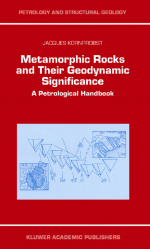Добрый день, Коллеги. Важное сообщение, просьба принять участие. Музей Ферсмана ищет помощь для реставрационных работ в помещении. Подробности по ссылке
Petrology and structural geology. Volume 12. Metamorphic rocks and their geodynamic significance. A petrological handbook / Петрология и структурная геология. Выпуск 12. Метаморфические породы и их геодинамическое значение. Петрологический справочник
Metamorphism is the sum of all transformations which cause a rearrangement of the elements of a rock at the atomic scale, leading to a recrystallization in the solid state (with or without a fluid phase), as a result of variations in temperature, pressure or of composition.This definition of metamorphism excludes the processes of surface alteration, which, functioning both at the atomic and ionic scale, lead chiefly to the destruction of rocks by leaching and mechanical disaggregation, and not to their transformation. The above definition does include diagenesis, the process which changes unconsolidated sediments into sedimentary rocks. Diagenesis consists in large part in a reduction of the sediment porosity by compaction; but it also implies recrystallization. Metamorphism generally takes place at higher temperature and pressure conditions than diagenesis, but the intrinsic nature of the physico-chemical mechanisms is the same for both processes. Metamorphism is generally related to orogenic or pre-orogenic phenomena, whereas diagenesis is related to the dynamics of sedimentary basins. This distinction is extremely subtle because sedimentary basins precede, follow or accompany orogenesis and their dynamics are therefore related. There is, incontestably, a problem in defining the limit between metamorphism and diagenesis which may not always be clearly resolved.
One criterion, based on illite crystallinity, is often used to limit the respective fields of metamorphism and diagenesis. This criterion (Fig. 1) measures the crystallographic evolution of phyllosilicates from argillaceous phases (typical of the diagenetic domain) up to micaceous phases (typical of metamorphism). The evolution passes through an intermediate domain, that of anchimetamorphism, which is considered either to be the final stage of deep diagenesis or the result of the first effects of metamorphism. <...>




